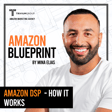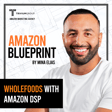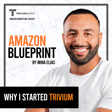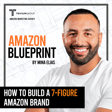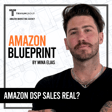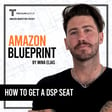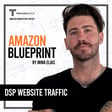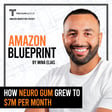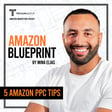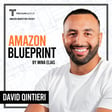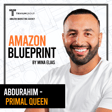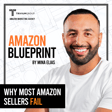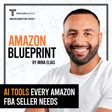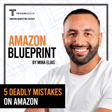Become a Creator today!Start creating today - Share your story with the world!
Start for free
00:00:00
00:00:01

Amazon PPC vs. DSP Advertising: Which Is Better for Scaling Your Brand?
Amazon ads can either make or break your business.
Here’s the truth:
PPC is where you start. It’s the foundation. The bread and butter.
DSP is the game changer—but only if your PPC is in order
In this episode you'll learn:
✅ Why Amazon PPC is the foundation of any successful ad strategy.
✅ How Amazon DSP unlocks first-party data to target real buyers—not just browsers.
✅ The secrets to building a full-funnel strategy that drives revenue and scales profitably.
Lesson: Growth comes when you stop wasting time and start playing smart.
📈 Ready to scale your Amazon Ads in 2025? Let me help you, click here: https://hubs.la/Q03dy0Z80
Transcript
Amazon Advertising: PPC vs. DSP
00:00:00
Speaker
Welcome back to the Amazon Blueprint Podcast.
00:00:05
Speaker
Amazon PPC or Amazon DSP? Which one is better? Am I ready for both? Am I ready for DSP? Am I ready for
Success Stories: Trivium's Campaigns
00:00:12
Speaker
PPC? I'm going to cover exactly what Amazon PPC and DSP are, who they're good for, who they're not good for.
00:00:18
Speaker
At Trivium, we run Amazon PPC and DSP campaigns for over 180 clients. And so we've seen what works and what doesn't work. And I'm going to share with you what's the difference between the two of them and which one is better. All right, so what is Amazon PPC?
00:00:29
Speaker
Amazon PPC is Amazon paper cook advertising. It's the advertising that you see natively on Amazon. So when you type in, you know, MMA nutrition electrolytes, it shows up some results. You're going to see a headline search ad, right? That big banner at the top.
00:00:40
Speaker
And then you're going to see, you know, four regular results that say sponsored in a small font. And then you're going to have a bunch of organic results. And then after that, going a video and then you're gonna have more
PPC Strategy: Focus on Sponsored Products
00:00:50
Speaker
organic results. Again, you're going for sponsored results and so on and so forth. Now, when you click on a listing, you're gonna go into a product detail page and you're gonna see you know somewhere near the buy box or maybe on the sides or whatever, you're gonna see some more ads, right? So all of that is considered Amazon PPC. you know The top, the headline search ad, that's sponsored brand. The video is sponsored brand. The ones that look just like the organic, they're considered sponsored products. so
00:01:11
Speaker
Amazon PPC is the absolute foundation. You shouldn't even worry about Amazon DSP without first going into Amazon PPC. You should definitely launch Amazon PPC, focus on sponsored products.
00:01:22
Speaker
80 to 90, I would say 90% of all of your ad spend in terms of PPC, not DSP. But 90% of your ads spend should go to sponsored products because those look very natural. They look very organic. Some people don't even know that they're ads.
00:01:34
Speaker
With the banner, with the video, people do know that they're ads. Now, the banner and the video, they definitely have their own use, right? Now, the banner is nice when you want to showcase something that you can't really communicate in your main image. The video is also nice if there's something special about your product that you can showcase in a video really quickly in the first three seconds.
00:01:49
Speaker
That's where you can use sponsored video. But for the most part, sponsored products will get the majority
PPC First: The Foundation of Advertising
00:01:54
Speaker
of the job done. Now, sponsored products is broken up into two categories, keywords and products. With keywords, it's very self-explanatory.
00:02:01
Speaker
What are all of the keywords that people are typing to look for your product? You know, you're gonna show up for those keywords. And then product targeting is basically when you click on a product, you scroll down, it says sponsor products related to this item. Those are the you know competitors that are basically bidding on that product page.
00:02:14
Speaker
And that is product targeting. That's where you can show up. So those two places basically generate 90% of the revenue or they should generate 90% of the revenue when it comes to PPC advertising. Now, Amazon PPC is the foundation. So if your Amazon PPC is not dialed, if you feel like you haven't gotten to a good point where your product is converting well, you know, and PPC is actually working, don't even consider DSP, right? So focus on PPC first because PPC is naturally going to be more profitable. There are certain things in DSP that are more profitable than PPC, but it's like a small thing, right? Which is like the bottom of the funnel stuff. like retargeting, loyalty, stuff like that, right? But the core focus, the thing that's gonna make you the most money is gonna be Amazon PPC. So focus on that first, build it up. Now, let's say you're converting well. Let's say you're profitable on Amazon.
Understanding DSP: Audience Targeting
00:02:58
Speaker
Now is a good time to consider Amazon DSP. Now, what is Amazon DSP? Amazon DSP is audience targeting, on and off Amazon. So instead of just, you know, typing in a keyword and then results showing up, you can actually identify audiences, people who visited their product, people who purchased the product, people who are in the market for a certain type of product because, you know, of their browsing history or their behavior. And so you can actually create these audiences and you can target them on and off Amazon. Now, I don't recommend off Amazon. 99% of the time, it doesn't really work, but on Amazon usually works pretty well. And so what we like to do is we like to build the funnel from the bottom up. The bottom is loyalty.
00:03:35
Speaker
If you have a consumable product, people who purchased your product in the past but haven't repurchased. A little bit above that, retargeting. People who viewed your product but have not made a purchase yet. Not on your product, not a competitor's product. Then above that, complementary products. So someone who bought a complementary product but hasn't visited your page or hasn't bought any of your competitors. Then we go a little bit higher. Now, the power of DSP is number one, it has that bottom of the funnel so it can actually do the retargeting.
00:03:58
Speaker
And then number two, it has a massive top of the funnel. So with PPC, you're limited because you type in the keywords and just depending on where you can rank, right, that's all the impressions that you can get. But with DSP, I can literally bring in an insane amount of people to my page because I can pull from other people's audience.
00:04:15
Speaker
So for example, Liquid IV, massive company, millions and millions of dollars a month in sales. What they're doing is they're spending a shit ton of money. They're in Costco, all this stuff. They're spending money on ads and they're bringing people directly into the listing. So a lot of people don't even type in a keyword or anything. They just make it onto Liquid IV's listing. What I could do is I could target every single person who's visited Liquid IV's listing, but has not purchased from them and has not visited my listing, which means they're a new audience. They're fresh to me. And those are like hundreds of thousands of people. And then I can showcase my listing in front of those people and hopefully bring them into my listing. And then once they're in my listing, I can retarget them with my retargeting DSP campaigns and get more and more sales. So that's the power of DSP. It's incredibly powerful.
Integrating PPC and DSP: Complete Funnel Strategy
00:04:54
Speaker
Now, if you're a brand that's just starting out, PPC is what's right for you If your PPC is working, if you're spending a good amount of money, would say at least, you know, 10,000, 15,000 a month on PPC, you're getting good traction, you're converting well, you're profitable on Amazon, your conversion rate is decent, right? Because DSP conversion is naturally gonna be a little bit lower because people do notice that it's an ad as opposed to, you know, how sponsored products is very organic, right? People are gonna notice that it's an ad, so conversion rate is naturally gonna be a little bit less.
00:05:21
Speaker
And when you're hitting people at the top of the funnel, conversion rate's gonna be less because it's the top of the funnel. But once you're a little bit profitable and your conversion rate is good, add DSP on top of PPC. That's what becomes really powerful because now you build a full funnel.
00:05:33
Speaker
You have people, you know, let's say in the middle, you have people typing in keywords, looking, seeing your products on Amazon, clicking on them, getting in there. Now at the bottom, you add retargeting. So people who don't purchase, you keep showing your ads in front of them until hopefully they do purchase. And then once they purchase, if you can, you can cross sell them other products or you can retarget them to get them to purchase again. So that's the bottom of the funnel. And the top of the funnel where you can get people from other products, all their audience that haven't ever you know made it or seen your listing. And you can start showing your listing in front of those people and build the top of the funnel. So you're growing the top of the funnel, which is going to be, ah again, a little bit less profitable. But in the long term, it's going to make you way more money.
00:06:10
Speaker
You're going to grow way bigger. And the beautiful thing is is you can also push subscribe and save if you're a product that's a consumable pushing subscribe and save and pushing new to brand with DSP. is a very powerful tool.
Product Suitability for DSP: Expert Consultation
00:06:21
Speaker
right. Which products don't work for DSP? Very simple.
00:06:24
Speaker
The very cheap ones won't work. It's going to be too costly, right? So you want to start at least at a 20, ideally $30 price point up until maybe 50 or 60 between 60 and 200. between sixty and two hundred it's a little bit, you know, kind of weird, right? And then once you hit 200, right, the more expensive ones, it works well because of like the retargeting capability. And all you need is one conversion for it to be worth it. So that's when it comes to price. In terms of what kinds of product, consumable products usually do really well with DSP. Products with like a very large variety, apparel,
00:06:55
Speaker
I'm not sure, right? I haven't seen a lot of good you know use cases for that on DSP. But in general, if you're looking to find out if your product is a fit for DSP, feel free to reach out. Just say, hey, I wanna learn about DSP.
00:07:07
Speaker
Is my product a fit? And then our VP of DSP, Sam, who's run, you know built Thrasio's entire DSP team, run DSP himself for over 300 brands. He's gonna take a look and he's gonna tell you, hey, I think DSP is right for you. So I'm just gonna ask you a few questions or say, I don't think this is right for you. All right, guys, see you in the next one.

